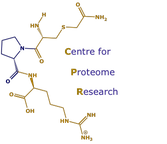What capabilities do you have?
14/05/15 09:43
We have an extensive suite of instrumentation. These instruments have all been brought into CPR by grants awarded to Rob and Claire (with other colleagues) and are primarily directed towards the research programmes that they have to support. However, we are very willing to engage with other groups, as collaborators or in the context of the Shared Rsearch Facility.
• 2006: Waters GC-TOF Premier GS/MS system
• 2009: Waters Xevo QqQ/nanoAcquity
• 2009: Waters Xevo QqQ/nanoAcquity
• 2010: Thermo Velos Orbitrap/nanoAcquity (upgraded to Elite in 2015 for metabolomics)
• 2010: Waters Synapt G2/nanoAquity high resolution ion mobility QToF
• 2010: Bruker Amazon high speed ion trap/nanoAcquity
• 2010: Bruker Ultraflex Extreme 1kHz MALDI-TOF/TOF
• 2012: Thermo QExactive Orbitrap instrument/Dionex u3000 nano
• 2013: Waters G2si IM-QTOF for intact protein research
• 2013: Waters G2si IM-QTOF/ nanoAquity for proteomics
• 2013: Waters Xevo TQS QqQ/nanoAcquity
• 2014: Waters MALDI-Synapt G2si imaging system
• 2014: Waters LAESI-Synapt G2si imaging system, upgrade to include DESI in 2015
• 2015: Thermo Fusion tribrid mass spectrometer
• 2015: Thermo QExactive HF mass spectrometer
• 2015: Access to Fluidigm CyTOF mass cytometer
.
• 2006: Waters GC-TOF Premier GS/MS system
• 2009: Waters Xevo QqQ/nanoAcquity
• 2009: Waters Xevo QqQ/nanoAcquity
• 2010: Thermo Velos Orbitrap/nanoAcquity (upgraded to Elite in 2015 for metabolomics)
• 2010: Waters Synapt G2/nanoAquity high resolution ion mobility QToF
• 2010: Bruker Amazon high speed ion trap/nanoAcquity
• 2010: Bruker Ultraflex Extreme 1kHz MALDI-TOF/TOF
• 2012: Thermo QExactive Orbitrap instrument/Dionex u3000 nano
• 2013: Waters G2si IM-QTOF for intact protein research
• 2013: Waters G2si IM-QTOF/ nanoAquity for proteomics
• 2013: Waters Xevo TQS QqQ/nanoAcquity
• 2014: Waters MALDI-Synapt G2si imaging system
• 2014: Waters LAESI-Synapt G2si imaging system, upgrade to include DESI in 2015
• 2015: Thermo Fusion tribrid mass spectrometer
• 2015: Thermo QExactive HF mass spectrometer
• 2015: Access to Fluidigm CyTOF mass cytometer
.
Proteomics as a service
14/05/15 09:38
How can I have proteomics samples run?
We are always willing to talk to colleagues about the potential for running new analyses. These can vary from simple 'quick look' analyses to complete and complex, fully biologically replicated analyses. In all circumstances, we adopt a model of 'defend the mass spectrometer form the sample'! In fact, mass spectrometers are remarkably robust; it is the delivery of peptides through a nanoflow high pressure chromatography system that causes the problems.
Biological samples can be delivered in exotic and complex matrixes, either reflecting the biological context of the sample or the sample work up chemistry imposed by the user m(detergent, PEG and glycerol might seem like a dream extraction buffer to you, but we are never going to run that sample for you!). We are very reluctant to receive samples that contain insoluble material, high concentrations of detergents, polymers such a polyethylene glycol (PEG), for example. A nanoflow high resolution column (75um diameter and 150mm long) costs, with trap, nearly £1,000 and is time consuming to exchange and optimise. You can see why we're reluctant to take anonymous samples!
It is far, far better if you come to talk to us before you attempt to prepare proteomics samples.
We are always willing to talk to colleagues about the potential for running new analyses. These can vary from simple 'quick look' analyses to complete and complex, fully biologically replicated analyses. In all circumstances, we adopt a model of 'defend the mass spectrometer form the sample'! In fact, mass spectrometers are remarkably robust; it is the delivery of peptides through a nanoflow high pressure chromatography system that causes the problems.
Biological samples can be delivered in exotic and complex matrixes, either reflecting the biological context of the sample or the sample work up chemistry imposed by the user m(detergent, PEG and glycerol might seem like a dream extraction buffer to you, but we are never going to run that sample for you!). We are very reluctant to receive samples that contain insoluble material, high concentrations of detergents, polymers such a polyethylene glycol (PEG), for example. A nanoflow high resolution column (75um diameter and 150mm long) costs, with trap, nearly £1,000 and is time consuming to exchange and optimise. You can see why we're reluctant to take anonymous samples!
It is far, far better if you come to talk to us before you attempt to prepare proteomics samples.
